Patagonia Adventures
Over the last several weeks with our many hikes and climbs we have seen the Fitz Roy group from many angles and up close and personal. However, we had not experienced the Torre Group (still within the Chalten Massif, but just west of Fitz Roy) very closely and we still had one major (for us) climb on the list for our trip if we were given another good weather window in the mountains. As luck would have it, a great window appeared for the three days before our scheduled departure back home from El Chalten. We decided to take advantage of this weather to hike up the Torre Valley, and attempt a climb of Aguja Dl'S, the southernmost granite spire in the Fitz Roy group. We were still a bit physically and mentally drained from our climb of Guillaumet, but we thought we would at least give it a shot.
The Torre Valley has a long and fairly complicated approach, and we knew that this trip would be physically demanding just to get to base camp. We woke up early, made a big breakfast, and headed out straight from our cozy cabin up a well maintained and popular hiking trail towards Laguna Torre. It is about 6 miles to the lake, but the trail is relatively flat, and the views are breathtaking. Near the beginning of the trail, you gain sweeping views of the valley with Cerro Torre (along with Fitz Roy the most magnificent and famous peak in patagonia) at its head. The views only improve as you get closer to the towering granite spires, and within about 2.5 hours we were at the lake soaking up the views.
The first obstacle on the approach hike is a tyrolean traverse over Rio Fitz Roy at the outlet of Laguna Torre. This fun crossing of the river involves attaching yourself and your heavy pack to a rope strung across the river using a harness and carabiners, and then pulling yourself hand over hand to the other side while in a horizontal position. I got across and waited for soraya on the other side. Before she started the traverse, two fast climbers approached with very light packs. Since we had very heavy packs and it would take her a while to cross, she offered to let them go first. They turned out to be Peter Ortner and Toni Ponholzer, two of the best Austrian climbers. We discussed our intended route with them and they happily gave us advice and route conditions.
Soraya had a good time crossing the river, and we continued our
soraya.dossa
5 chapters
16 Apr 2020
Torre Valley
Patagonia, Argentina
Over the last several weeks with our many hikes and climbs we have seen the Fitz Roy group from many angles and up close and personal. However, we had not experienced the Torre Group (still within the Chalten Massif, but just west of Fitz Roy) very closely and we still had one major (for us) climb on the list for our trip if we were given another good weather window in the mountains. As luck would have it, a great window appeared for the three days before our scheduled departure back home from El Chalten. We decided to take advantage of this weather to hike up the Torre Valley, and attempt a climb of Aguja Dl'S, the southernmost granite spire in the Fitz Roy group. We were still a bit physically and mentally drained from our climb of Guillaumet, but we thought we would at least give it a shot.
The Torre Valley has a long and fairly complicated approach, and we knew that this trip would be physically demanding just to get to base camp. We woke up early, made a big breakfast, and headed out straight from our cozy cabin up a well maintained and popular hiking trail towards Laguna Torre. It is about 6 miles to the lake, but the trail is relatively flat, and the views are breathtaking. Near the beginning of the trail, you gain sweeping views of the valley with Cerro Torre (along with Fitz Roy the most magnificent and famous peak in patagonia) at its head. The views only improve as you get closer to the towering granite spires, and within about 2.5 hours we were at the lake soaking up the views.
The first obstacle on the approach hike is a tyrolean traverse over Rio Fitz Roy at the outlet of Laguna Torre. This fun crossing of the river involves attaching yourself and your heavy pack to a rope strung across the river using a harness and carabiners, and then pulling yourself hand over hand to the other side while in a horizontal position. I got across and waited for soraya on the other side. Before she started the traverse, two fast climbers approached with very light packs. Since we had very heavy packs and it would take her a while to cross, she offered to let them go first. They turned out to be Peter Ortner and Toni Ponholzer, two of the best Austrian climbers. We discussed our intended route with them and they happily gave us advice and route conditions.
Soraya had a good time crossing the river, and we continued our
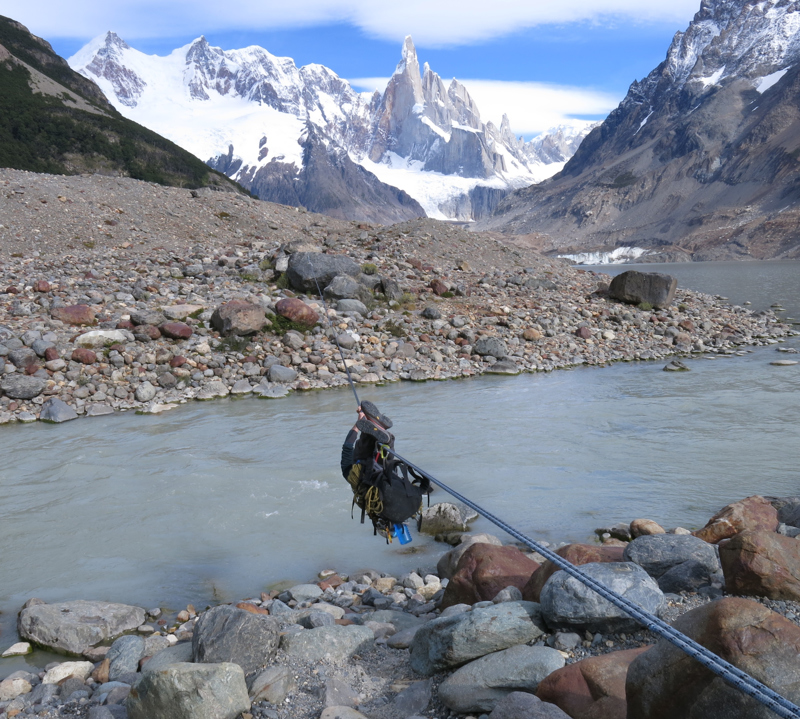
approach up the valley. Like many places throughout the world, glacial retreat has lead to unstable and changing conditions in the Torre Valley, and this has complicated access into the Torre Valley. There is a very large and unstable moraine that must be negotiated past Laguna Torre that involves some scrambling up a ridge, and then a short descent down a very loose gully using a fixed rope prior to down-climbing very loose scree to finally get past the lake. Then, you traverse the edge of the Glaciar Grande over a thin veneer of loose dirt and rock over very slippery ice. This section was only a few miles, but it took much longer than the 6 miles to the lake and we were happy to be past it.
We then crossed over a cascading waterfall to the Glaciar Grande at a location relatively free of crevasses between ice falls. This section of the approach was quite beautiful and fun. The Glacier is huge and
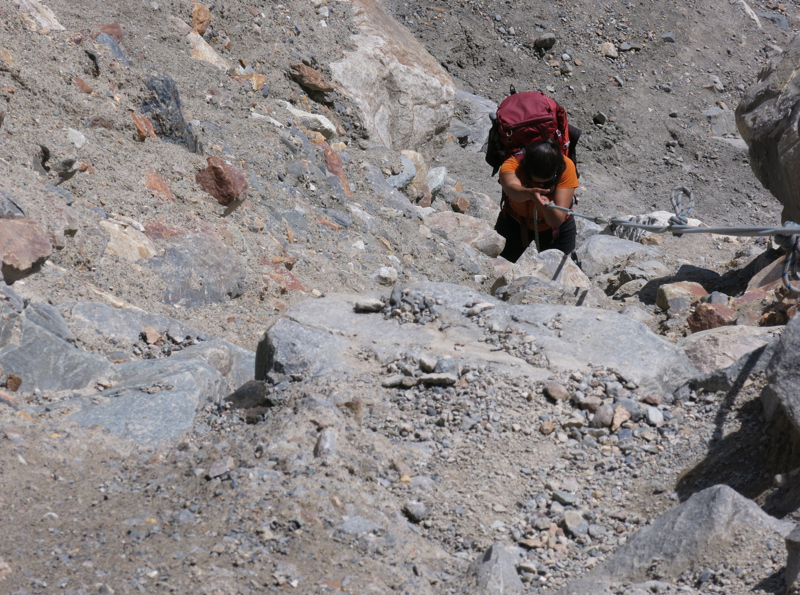
lined by towering peaks with jagged seracs. Cerro Torre and the west faces of the Fitz Roy Group lay ahead in mind boggling granite precipitousness. Crystal blue glacial streams flow over the white ice, winding through narrow gorges of various heights. Some of these streams provided a bit of excitement, as they were flowing quite quickly and just barely narrow enough to jump over. A fall here would have been a very cold and terrifying waterslide into the recesses under the glacier. Many of the streams disappeared in gaping holes in the glacier that fell to unknown depths. It was a beautiful and alien landscape.
Several glaciers come to a confluence in the Torre Valley, and where they meet large hills of icy rubble form at the terminal moraines. These areas proved difficult to navigate, as the hills were very slippery and there was no telling what lay behind the next one. We slowly navigated the junction between the Glaciar Grande, and the Glaciar Torre that would be our next path up the valley. When we finally emerged from the moraine, another expansive, and much more debris filled glacier lay ahead. The glacier was full of noises that reminded me of a beach at low tide. There was a constant gurgling noise as the ice melted and water percolated through the overlying rocks and gravels. In place of crashing waves, there was the constant thunder of falling seracs from the surrounding glacial icefalls. Cerro Torre was now towering directly ahead of us as we moved towards Campemento Niponino located at its base.
Cerro Torre is a peak with an interesting and troubled history. It was long considered unclimbable due to its immense, sheer and rime ice covered faces on all sides. In the middle of the 20th century, serious attempts were made to reach the summit, many of which were deadly and full of controversy. The most heated dispute that continues to this day are the several attempts that one Italian climber named
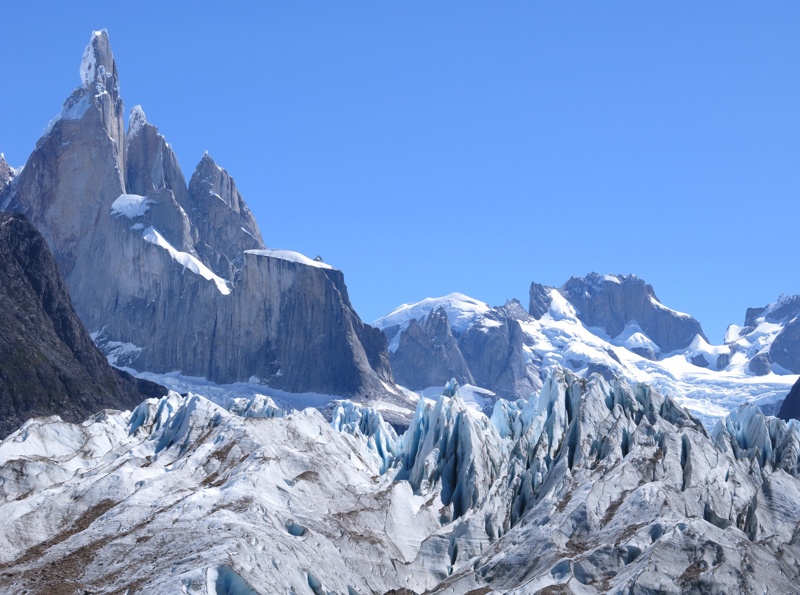
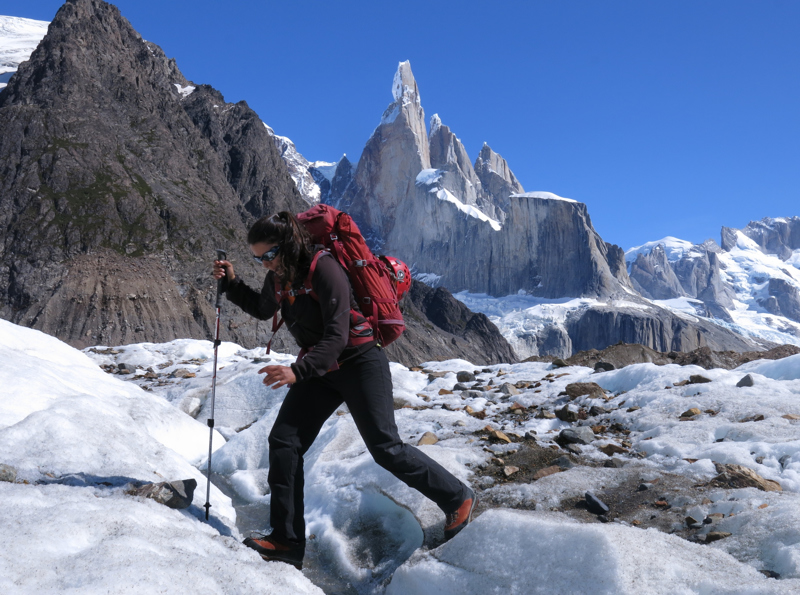

Maestri made of the peak. Meastri claimed to have made the first ascent of the peak, but serious doubts were raised that he actually gained the summit. His climbing partner (the much loved Toni Egger) died on the climb, leaving Maestri the only witness to the attempted climb. Embarrassed and enraged from doubts of his ascent, Maestri vowed to climb another route of the peak, in winter no less to shame his accusers.
The tactics Maestri used for this "second" climb are nearly universally viewed as shameful. He used a helicopter to fly in a hut for a base camp near the base of the mountain, then he proceeded to use a huge air compressor to drill hundreds of bolts into the wild mountain so that he could artificially aid his way up the mountain, and ignore natural climbing features presented by the peak. He did not even make it to the top of the mountain on this ascent, stating that the ice mushroom on the peak did not count as a part of the mountain, though future ascents found rock above where his bolt ladder ended.
In the last few years climbers have climbed this route using other techniques (referred to as "fair means") including Peter Ortner (referenced above) with his climbing partner David Lama. Other climbers removed many of the bolts from the original "Air Compressor Route" constructed by Maestri, with mixed praise and anger from the climbing community. There have been further controversies on the mountain, but I will not go into them as this has already been a lengthy tangent. Leave it to say that the peak is historic, very hard to climb, very beautiful, and there are some very good climbers making some impressive ascents of the peak recently.
So, back to us, we continued up the Glaciar Torre for what felt like a very long time and reached the camp at its base. This camp is in a beautiful location directly between Cerro Torre and Cerro Fitz Roy, and there are many nice locations for sheltered tent spots. Here we has a decision to continue on to our intended camp at campemento Polacos across the valley about an hour (a hard hour) away, or to stay in this camp. For any hope at completing our route in a timely way, we would have to continue to the Polacos camp, but there was no certainty that camp sites would exist there as a large part of the camp had collapsed with the unstable moraine on that side of the valley. I also know that Soraya was feeling quite physically and mentally tired from our previous climb and the long approach. In the end we decided that the climb was not going to happen, and that it would be better to enjoy our amazing surroundings while not pushing our luck.
I still had a bit of energy and I wanted to see what the beginning of the climb looked like should I ever return (hopefully!) since the approach gully accesses many of the west faces of the Fitz Roy Group. I negotiated another squirly icy rubble pile and climbed a loose moraine to reach Polacos. It was obvious that a large part of the historic camp was now laying at the bottom on the valley. However, there was a large camping area about 10 minutes uphill and north of Polacos with several parties that were going to attempt a variety of routes the next day.
I continued up to the gully that begins the scramble to the base of the granite spires. As I gained elevation, the full Torre group lay before me in its unique jagged form surrounded by flowing glaciers. I continued as far as I could before I decided that the hour necessitated my return. I returned to camp in time to eat dinner with Soraya and watch a spectacular sunset with the characteristically bizarre cloud formations that I have only witnessed in Patagonia. This had been a valley that I had wanted to visit for a very long time, and it did not disappoint.
We woke up early the next morning to see the sunrise. We walked about 30 minutes across the valley so that we could get a clear view of the Torre spires, and we waited for the sun to hit the peaks. The rime ice capping Cerro Torre began to turn a brilliant pink, and then very quickly the Torre peaks lit up in a bright golden glow illuminating a cloudless deep blue sky. The surrounding glaciers then progressively transitioned from pink to luminous orange. Another rare and beautiful day began in the Torre Valley.
We packed up camp and began our return trip after a warm breakfast. We had food for three days, so we decided to take a more leisurely pace and camp at Laguna Torre for one more night. This gave us time

to explore the alien glaciated landscape. We explored small ice caves, and peered into the deep blue holes in the ice. The day was a bit warmer, and this lead to more water in the glacial streams, and more exciting leaps across them. We negotiated the return trip a bit easier having done it the day before, but we were still glad to reach the lake and put down our packs.
We set up camp in a nice sandy spot next to the river, inflated our cushy sleeping pads, and rested outside our tent in the partial shade of the beech tree forest. We relaxed watching birds chase insects in the trees, and listening to the river. We leisurely ate another freeze dried dinner of lasagna (soraya has vowed not to eat pasta again for at least 6 months), and ambled up a short path to a viewpoint above the lake to watch the sunset. Cerro Torre sporadically peaked through the clouds as the weather window came to a close. Many scavenging
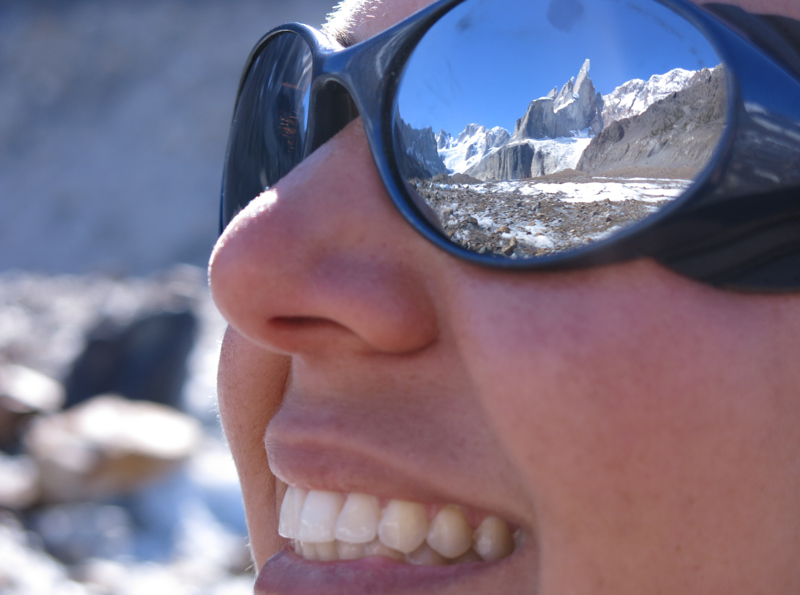
falcons ventured quite close to us, searching among the rocks for food as we lay taking in our last night in the Patagonian mountains.
The next day we woke to light rain and wind as the next storm approached. We packed up and headed out, trying to beat the wall of rain that we could see heading down the valley. On the hike back to El Chalten, we spotted pairs of patagonian parakeets playfully squawking and flying from tree to tree. A tiny little owl peared at us from a nearby tree with a miniature scowl that Soraya found quite adorable.
The hike was a little rainy, but not too bad, and we quickly made it back to our cozy cabin. We un-shouldered our packs for the last time of the trip, and celebrated another amazing hike by sharing a liter of Quilmes Beer outside in the sun. We were a little sad to have finished our final Patagonian adventure, but (unbeknownst to Soraya), I was
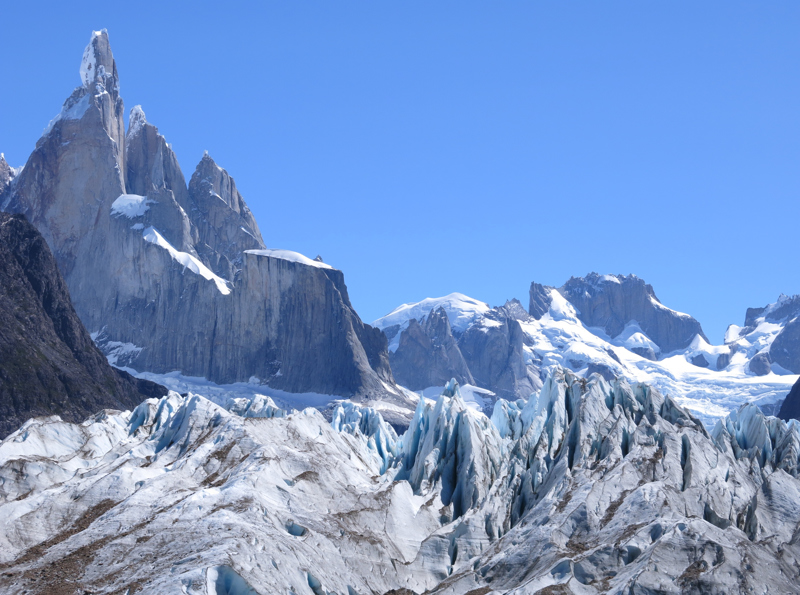
already scheming for our next adventures in the Cascades, and maybe even a return trip to this magical place. Until next time!
You know... they say that if you eat the Calafate Berries, you are destined to return to Patagonia...
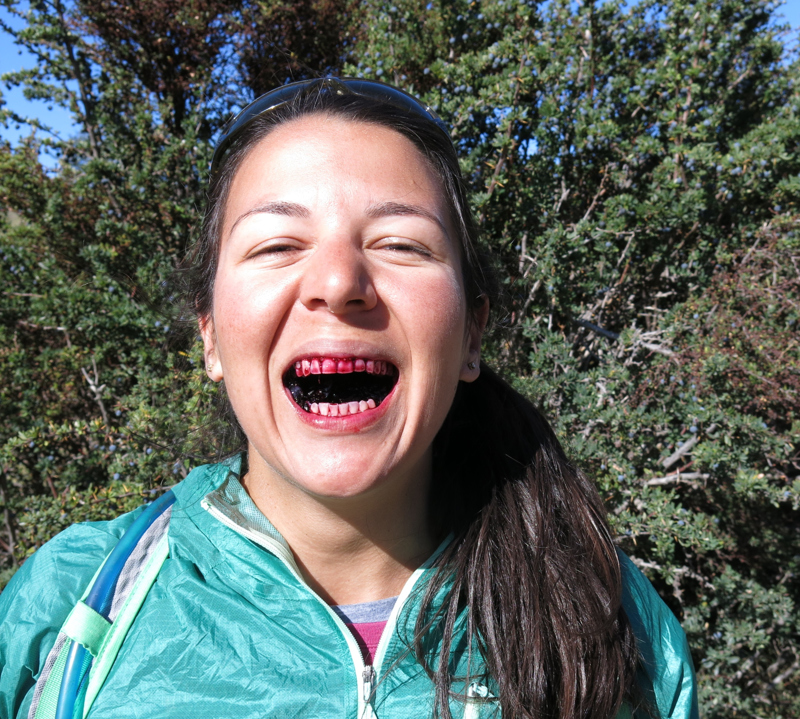
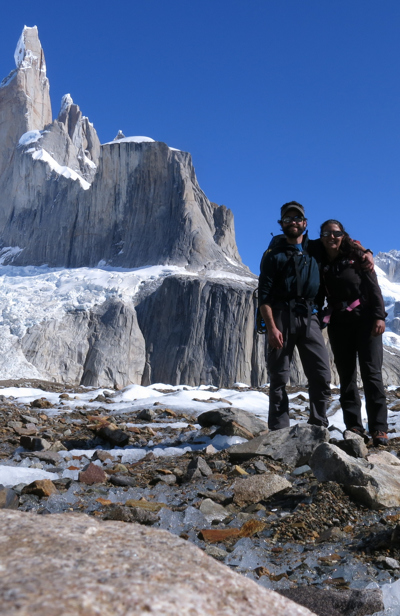
Share your travel adventures like this!
Create your own travel blog in one step
Share with friends and family to follow your journey
Easy set up, no technical knowledge needed and unlimited storage!
© 2025 Travel Diaries. All rights reserved.